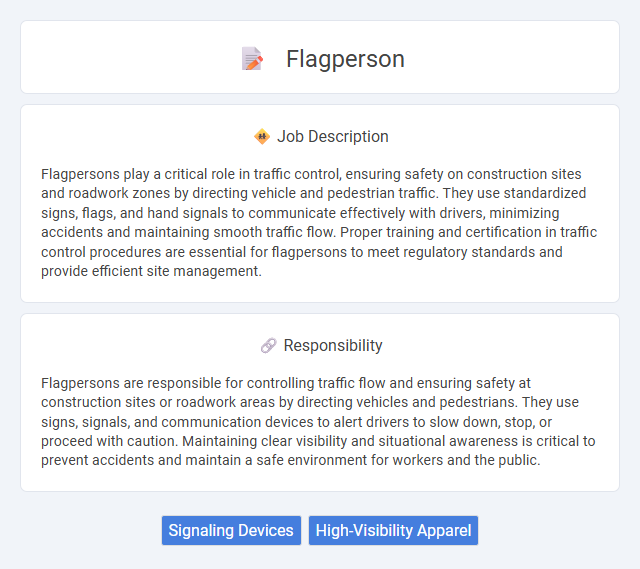
Flagpersons play a critical role in traffic control, ensuring safety on construction sites and roadwork zones by directing vehicle and pedestrian traffic. They use standardized signs, flags, and hand signals to communicate effectively with drivers, minimizing accidents and maintaining smooth traffic flow. Proper training and certification in traffic control procedures are essential for flagpersons to meet regulatory standards and provide efficient site management.
Individuals with good physical stamina and strong attention to safety protocols are more likely to be suitable for a Flagperson job. People who can maintain focus for long periods and communicate clearly in noisy, outdoor environments will probably perform well. Those with certain health conditions that affect mobility or hearing might find this job challenging.
Qualification
Flagpersons must possess comprehensive knowledge of traffic control regulations and safety protocols to effectively manage vehicle and pedestrian movement at construction sites or roadworks. Essential qualifications include certification in traffic control or flagging, completion of OSHA safety training, and physical fitness to endure outdoor working conditions. Strong communication skills and the ability to respond quickly to changing environments are critical for ensuring site safety and minimizing accidents.
Responsibility
Flagpersons are responsible for controlling traffic flow and ensuring safety at construction sites or roadwork areas by directing vehicles and pedestrians. They use signs, signals, and communication devices to alert drivers to slow down, stop, or proceed with caution. Maintaining clear visibility and situational awareness is critical to prevent accidents and maintain a safe environment for workers and the public.
Benefit
Flagperson roles likely provide benefits such as enhanced workplace safety through traffic control, reducing the risk of accidents on construction sites. The position may offer steady employment opportunities in various industries, including construction and road maintenance. Compensation might include competitive wages and potential access to job site perks like training and safety gear.
Challenge
Flagperson roles likely involve significant challenges due to the need for constant vigilance and precise communication to manage traffic safely. The probability of facing high-pressure situations increases in construction zones or areas with heavy vehicle flow, requiring quick decision-making skills. Adapting to varying weather conditions and maintaining concentration over long periods may further add to the job's demanding nature.
Career Advancement
Flagperson roles offer foundational experience in traffic control, essential for advancing into supervisory or site management positions within construction and infrastructure industries. Mastery of safety protocols and communication skills in this entry-level job can lead to certifications and specialized training opportunities, paving the way for career growth. Professionals often transition into roles like traffic control supervisor, construction safety officer, or project coordinator, reflecting strong upward mobility within related fields.
Key Terms
Signaling Devices
Flagpersons operate essential signaling devices such as paddles, flags, and stop/slow signs to control traffic flow at construction or accident sites. These devices provide clear visual communication to drivers and pedestrians, ensuring safety and reducing the risk of accidents. Proper use of signaling equipment is critical for effective traffic management and compliance with safety regulations.
High-Visibility Apparel
Flagpersons are required to wear high-visibility apparel meeting ANSI/ISEA 107 standards to ensure maximum safety on construction sites and roadworks. This specialized clothing features fluorescent colors and reflective strips that enhance visibility in low-light conditions and busy traffic environments. Proper high-visibility apparel significantly reduces the risk of accidents by making flagpersons easily recognizable to drivers and equipment operators.
 kuljobs.com
kuljobs.com